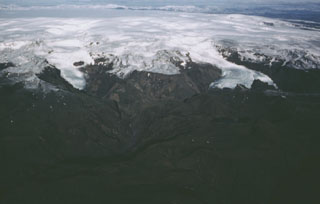Report on Katla (Iceland) — 26 July-1 August 2017
Smithsonian Institution / US Geological Survey
Weekly Volcanic Activity Report, 26 July-1 August 2017
Managing Editor: Sally Sennert.
Please cite this report as:
Global Volcanism Program, 2017. Report on Katla (Iceland) (Sennert, S, ed.). Weekly Volcanic Activity Report, 26 July-1 August 2017. Smithsonian Institution and US Geological Survey.
Katla
Iceland
63.633°N, 19.083°W; summit elev. 1490 m
All times are local (unless otherwise noted)
On 29 July the Iceland Met Office (IMO) reported that a glacial outburst flood (jökulhlaup) in the Múlakvísl river, SE of Katla, had begun, and a M 3 earthquake along with a few smaller earthquakes were located in the N part of the caldera. Nearby seismic stations detected tremor possibly linked to the flood, though a subglacial volcanic component was not ruled out. The Aviation Color Code was raised to Yellow, the second lowest level on a four-color scale. The public was advised to stay away from the river; it was dark colored and had a sulfur odor. By 31 July the jökulhlaup had subsided with conductivity measurements and tremor slowly reaching normal levels. The Aviation Color Code was lowered to Green.
Geological Summary. Katla volcano, located near the southern end of Iceland's eastern volcanic zone, is hidden beneath the Myrdalsjökull icecap. The subglacial basaltic-to-rhyolitic volcano is one of Iceland's most active and is a frequent producer of damaging jökulhlaups, or glacier-outburst floods. A large 10 x 14 km subglacial caldera with a long axis in a NW-SE direction is up to 750 m deep. Its high point reaches 1380 m, and three major outlet glaciers have breached its rim. Although most recorded eruptions have taken place from fissures inside the caldera, the Eldgjá fissure system, which extends about 60 km to the NE from the current ice margin towards Grímsvötn volcano, has been the source of major Holocene eruptions. An eruption from the Eldgjá fissure system about 934 CE produced a voluminous lava flow of about 18 km3, one of the world's largest known Holocene lava flows. Katla has been the source of frequent subglacial basaltic explosive eruptions that have been among the largest tephra-producers in Iceland during historical time and has also produced numerous dacitic explosive eruptions during the Holocene.

